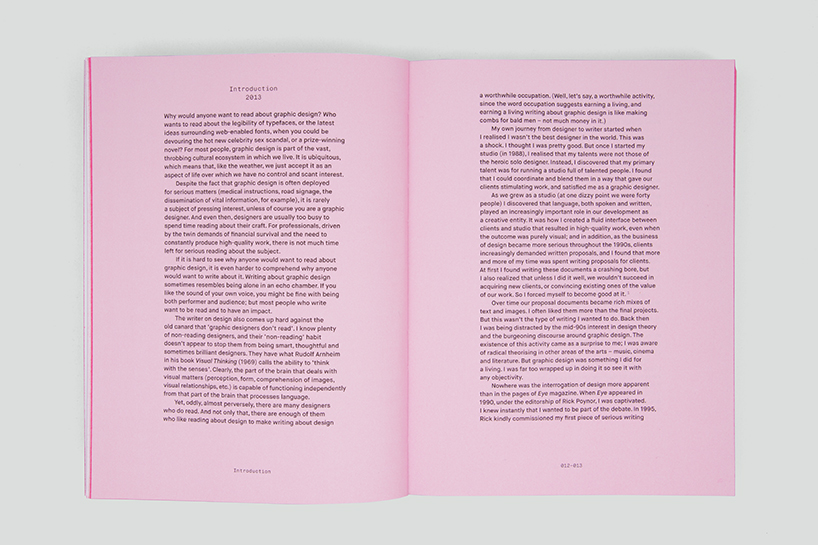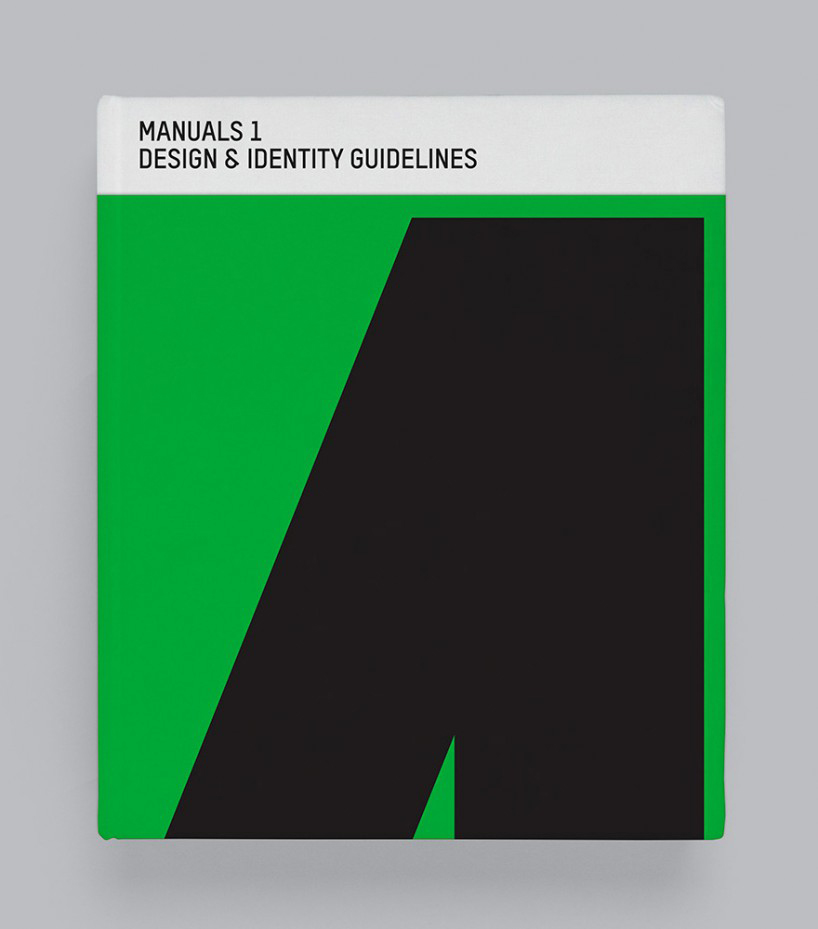interview with grpahic designer and writer adrian shaughnessy
adrian shaughnessy is a graphic designer and writer based in london. he formerly ran the design company intro and today he runs shaughnessyworks, a consultancy combining design and editorial direction. together with tony brook of spin he founded unit editions a progressive publishing venture producing high-quality and good value books on graphic design and visual culture. he is consultant creative director for commonland and a senior tutor at the royal college of art.
designboom: what first sparked your interest in design?
adrian shaughnessy: like most of my generation I came to graphic design through music. I harbored the usual acned ambitions to be in a band. but since I had zero musical ability that wish was never likely to be fulfilled. for me, the next best thing after the music was the cover art. and so I parlayed a small talent for art – I could draw – into a career in graphic design. I had no art school training. I trained in an old fashioned pre-digital studio where I was taught the basics by older designers. learning came easily to me: I intuitively understood form and pattern, and felt an instinctive affinity with letterforms. I had an innate feeling for how graphic elements could be used to create balance, or the opposite, distortion.

mute audio documents packaging
client: mute records
DB: what do you enjoy the most about design?
AS: I like graphic design’s omnipresence in daily life. I like the fact that it shapes and gives meaning to our environment – physical and electronic. probably only architecture can claim to have more impact on our visual environment. of course, most of what we see is vacuous, or worse, a sort of commercial hysteria. but there are also many good and worthwhile uses of graphic design; usages that make our lives better – signage, information design, user interface design, data visualization, etc. and there is lots of really great avant garde design being done for bodies such as arts organizations, tiny record labels and radical publishers that is, in my view, more interesting, complex and sophisticated than much of the contemporary art we see, which has embraced conceptualism at the expense of aesthetic expression.

MSII (mute synth 2) logo
client: mute records
DB: how important do you think it is for designers to write?
AS: I’ll quote the great norman potter here, whose book what is a designer is essential reading for designers of all kinds: ‘this aspect of design work is frequently underestimated: an ability to use words clearly, pointedly, and persuasively is at all times relevant to design work.’
although I personally agree with potter’s view, I think you can still be a very good designer without possessing writing skills. some designers have such a highly developed visual sense that language is secondary. however, for anyone involved in editorial design, I’d say it is essential to have writing skills. one of the ways that I discovered an interest in writing was through editing poor copy given to me by clients. I also think that when it comes to dealing with clients, the ability to write clear proposals is essential.

40 years of disruption
book design: adrian shaughnessy
client: virgin records
DB: what design insights has writing given you that you weren’t aware of as a designer?
AS: writing proposals helped me inject clarity into my writing. I couldn’t bear the thought of clients not reading our proposals, or not fully understanding them – or worse, misunderstanding them. so I worked at making my texts as concise and readable as possible. there’s a place in my life for mystery and ambiguity, but in my professional life I’m obsessed with clarity in both writing and graphic expression.
also, my interest in writing led me to an engagement with design theory, and ultimately to an interest in design history. both of these avenues were closed to me before my interest in writing emerged.

ken garland ‘structure and substance’
written by adrian shaughnessy
designed by spin
published by unit editions

ken garland ‘structure and substance’
DB: what impact do you think online resources have had on the design work being produced today?
AS: there is a vast amount of visual material available online – most of it free – and it has undoubtedly contributed to a widening of appreciation of design’s past and its diversity, especially amongst young designers. I work with a 20-something designer who says he’s only interested in dead designers. he wouldn’t have said that 10 years ago. back then he’d have been obsessed with the latest trendy styles and the hot designers.
while books have contributed to this interest too, the influence of blogs devoted to archiving both the past and the contemporary scene, have contributed to a wider familiarity with design of all kinds – past and present – which in turn has led to an enriching of contemporary graphic expression.
of course, much of the visual archiving of material comes without context, without critical appraisal, and even without basic credits. this is bad, but perhaps it’s this lack of context that drives people to seek out more information from books.
I also think there is a case to be made for the influence of design writing online in the development of a more critical discourse around design. the influence of design observer has been huge in this regard.

scratching the surface (essay)
written by adrian shaughnessy
designed by spin
published by unit editions

scratching the surface (essay)
DB: given the increasing number of online platforms for exposure of design work and learning resources how important is a formal qualification in design today?
AS: today it is highly unlikely that anyone would be able to do what I did and get trained in a studio. when you consider the vast pool of design graduates that is available to employers, why would they want to hire a novice?
however, I think there are huge shifts taking place in design education. the escalating fees are forcing alternative educational models to emerge – some good, some bad. I also think that the internet has provided an alternative platform for learning – remote learning. I see students and young designers using youtube tutorials to learn stuff that would take weeks of teaching if it were taught in schools. having said that, one of the best things about a good design school is the sense of community and shared experience. that’s hard to replicate elsewhere.
DB: how do you prepare your students at the RCA for life after / outside of school?
AS: at the RCA I’m dealing with postgraduate students. many of them are better read, more able, and more talented than me. sometimes the only thing I have to offer them is experience. and I found that I often end up learning as much from them as they do from me.
the teaching I deliver is through critique, intense discussion, and challenging them to be self-sufficient autonomous practitioners. when I first started teaching at the RCA I was worried by the lack of interest in professional matters amongst the students. but I got over that. they have a sort of fearlessness that I can only admire. all I can hope to do is to help them acquire the ability to be adaptable in a world of change. I suppose what I try to do is help them learn how to learn.
I also stress collaboration as a vital contemporary design skill – perhaps the most important contemporary design skill.

herb lubalin – american graphic designer, 1918—81
written by adrian shaughnessy
designed by spin
published by unit editions

herb lubalin – american graphic designer, 1918—81
DB: what big lessons have learned yourself since you began teaching?
AS: I’ve learned that you can’t prepare students for a specific role or career. for a start it might not be there in two years time – think of the emphasis on leaning how to make CD-ROMs a several years ago. no sooner had people learned the techniques of programming CD-ROMs than they were redundant.
what you can do, however, is prepare them for a world of near constant change – and an acceptance of the fact that jobs for life are becoming rarer, and that most of us will have to retrain at some point in our working lives.
DB: do you think that there are aspects of being a ‘modern’ graphic designer that are overlooked in design curriculum?
AS: unlike most of my friends who run studios, I think design courses are by and large pretty good. some of my friends get annoyed that students aren’t oven-ready designers – all trussed up and ready to start producing. in fact, I think most of the graduates are actually ahead of the pack, and it’s the studios and clients who are lagging behind.

manuals 1 – design and identity guidelines
edited by tony brook, adrian shaughnessy & sarah schrauwen
design by spin
published by unit editions

manuals 1 – design and identity guidelines
DB: unit editions has quickly established itself as one of the best publishers of graphic design books – could you tell us a bit about how you come to choose your titles and the dynamic of your collaboration with tony brook?
AS: we set unit editions up with the intention of publishing the books we would like to see in existence, and which we were not seeing other publishers producing. that’s still our only criteria: do we want to see a book on this subject published? if the answer is yes, we go ahead. I can’t see us ever producing a title that we had no interest in.
tony looks after visuals and I look after words, although we both have strong views on each other’s areas. all major decisions are taken jointly. this goes back to my point about the importance of collaboration – something I drum into my students constantly.

FHK henrion: the complete designer
written by adrian shaughnessy
designed by spin
published by unit editions

FHK henrion: the complete designer
DB: you have just announced, supernew supergraphics, unit’s second book on this topic – what fascinates you the most about this area of graphics and what can we expect from the new book?
AS: the first book looked back over the history of the supergarphics movement in 1960s america. it looked at a group of postmodernist architects (they were called the supermannerists) who applied paint to walls (an architectural taboo at the time), and allowed their designs to spill over and break out of the surfaces they were applied to. the new book has a much greater contemporary focus. most of the work shown is from the last five or six years. it’s a phenomenon that unites architecture, design and art in a fascinating way.

supernew supergraphics
edited by tony brook, adrian shaughnessy & sarah schrauwen
design by spin
published by unit editions
DB: what other interests do you have that people might be surprised to learn of?
AS: I’m a bit of a cycling nut. it’s a fairly recent obsession and I’m strictly amateur. but few things give me more pleasure than cycling. and a well-made bike is an almost perfect piece of technology. like a knife and fork, it is a technology that’s hard to improve upon. you can tweak it and experiment with construction and materials, but essentially a bike is a bike – and it’s perfect.
I’m also a cinema nut. I’m besotted with films of all kinds – contemporary cinema and the cinema of the past. cinema is a bit like a bicycle. you can experiment and apply avant garde techniques – but in the end, it’s hard to improve on the format. you can’t beat sitting in darkened room and suspending normal life for 90 minutes. I watch a lot of experimental cinema – but for me, directors like fritz lang, werner herzog, jean luc godard and many others, have developed an art form that is near to perfection.
DB: do you have any superstitious beliefs or rules that you live by?
AS: I’m spectacularly un-superstitious. I often think I should pay more attention to patterns of behavior and look for possible omens and signs. but I’m too boringly pragmatic to believe in anything other than the fact that the universe is pure randomness.
DB: what’s your personal motto?
AS: read everything – and when you’ve read everything, read it again.
graphic studio interviews (193)
logo design (245)
unit editions (10)
PRODUCT LIBRARY
a diverse digital database that acts as a valuable guide in gaining insight and information about a product directly from the manufacturer, and serves as a rich reference point in developing a project or scheme.



















